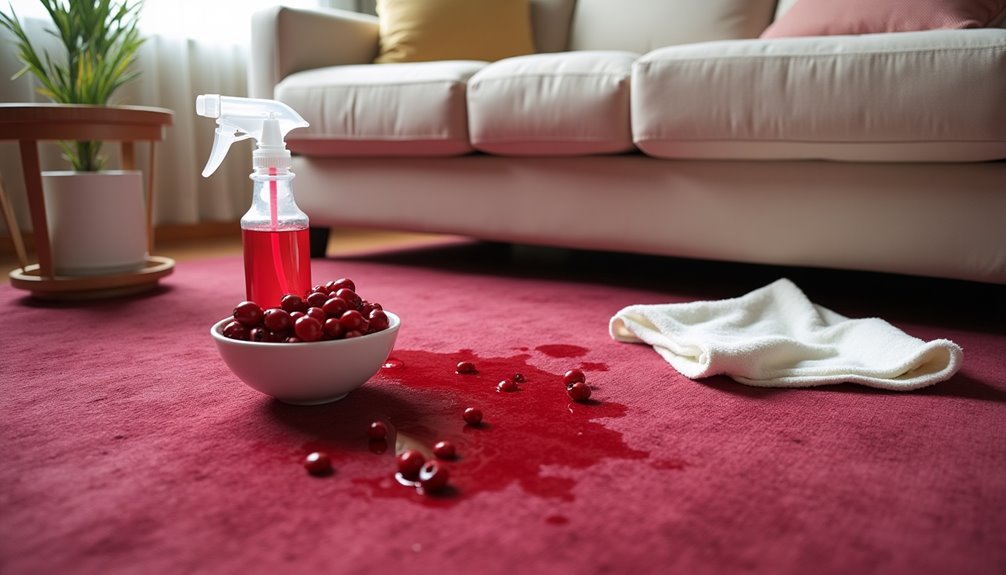To get cranberry juice out of the carpet, start by blotting the stain with a clean cloth to absorb excess liquid—don't rub it. Mix ⅔ cup rubbing alcohol with 2 tablespoons of white vinegar and apply it to the stain using a sponge, letting it sit for 10 minutes. Then, gently dab with a damp cloth until the stain lifts. Rinse with cold water and blot dry. Stick around to uncover more useful tips for stubborn stains.
Key Takeaways
- Blot the cranberry juice stain with a clean cloth to absorb excess liquid without rubbing to prevent deeper penetration.
- Prepare a cleaning solution by mixing ⅔ cup of rubbing alcohol with 2 tablespoons of white vinegar.
- Apply the cleaning solution to the stain using a sponge and let it sit for 10 minutes without scrubbing.
- After 10 minutes, gently dab the stain with a damp cloth, repeating as necessary until the stain is lifted.
- Rinse the area with cold water, blot dry, and allow it to air-dry completely to prevent mildew.

When you spill cranberry juice on your carpet, don't panic; acting quickly can save your flooring from a stubborn stain. The first thing you should do is to grab a clean white cloth or a paper towel. Gently blot the stain to absorb the excess liquid. Avoid rubbing the stain, as this can push the juice deeper into the carpet fibers, making it harder to remove. You want to soak up as much of the juice as possible before moving on to your cleaning solution.
To create an effective cleaning solution, mix ⅔ cup of rubbing alcohol with 2 tablespoons of white vinegar in a bowl. This combination is powerful for tackling those pesky cranberry stains. Once you've prepared your cleaning solution, take a sponge and apply it directly to the stained area. Let it sit for about 10 minutes to give the solution time to break down the stain. During this time, resist the urge to scrub; instead, let the solution do its work.
After 10 minutes, return to the area and gently dab the stain with a clean, damp cloth. This process helps lift the stain out of the carpet fibers. You may need to repeat this step several times, switching to a fresh section of the cloth each time, until you notice that no more liquid is being absorbed. Patience is key here; taking your time will yield better results.
If you find yourself dealing with dried stains, the method changes slightly. In this case, you'd use an oxygen-based bleach mixed with cool water, following the manufacturer's instructions for application. This technique can help dissolve those stubborn dried stains, but make sure to test the solution on an inconspicuous area of your carpet first to ensure it won't cause any discoloration.
Once you've successfully removed the cranberry juice stain, don't forget the final step: rinsing the area. It's crucial to rinse the cleaned area with cold water to remove any remaining cleaning solution. After rinsing, blot the area dry with a clean cloth to absorb any excess moisture. Finally, let the carpet air-dry completely. This is essential to prevent mildew, which can develop if the carpet remains damp for too long.
Frequently Asked Questions
Does Cranberry Juice Come Out of Carpet?
Yes, cranberry juice can come out of carpet if you act quickly.
You'll want to blot the stain immediately with a clean cloth to absorb as much juice as possible.
After that, mix rubbing alcohol and white vinegar, apply it to the stain, and let it sit for a few minutes.
Rinse with clean water and blot dry.
For stubborn stains, consider using a commercial carpet cleaner designed for tough stains.
Does Cranberry Juice Stain Come Out?
So you thought cranberry juice would be a refreshing addition to your day, huh?
Unfortunately, those vibrant stains can be quite stubborn.
But don't lose hope! If you act quickly, you can often lift the stain with a mix of rubbing alcohol and white vinegar.
Blot the area gently, rinse it well, and you might just save your carpet.
How to Get Cranberry Sauce Out of a Carpet?
To get cranberry sauce out of your carpet, act quickly.
Blot the stain with a clean white cloth to soak up excess sauce—don't rub, or you'll make it worse.
Mix 1 tablespoon of liquid dish soap with 2 cups of cool water, then gently sponge the stain from the outside in.
Rinse the area with cold water and blot dry.
If needed, try a vinegar and rubbing alcohol mixture for tough stains.
What Should I Do if I Spill Juice on My Carpet?
You've just spilled juice on your carpet, and panic sets in.
Don't worry; you can fix this! First, quickly blot the spill with a clean cloth to soak up as much juice as possible—don't rub it!
Next, mix rubbing alcohol with vinegar, apply it to the stain, and let it sit.
Blot again until the stain lifts, rinse, and dry the area carefully.
You'll be amazed at how good your carpet can look again!
Conclusion
Getting cranberry juice out of your carpet might feel like a daunting task, but with the right approach, it's as manageable as sailing on a calm sea. Remember to act quickly, blot the stain, and use the right cleaning solution to avoid any lasting damage. Just like a persistent tide, stains can be washed away with patience and the right techniques. So, don't let a little spill sink your ship; tackle it head-on and restore your carpet's beauty!
Cindy thoroughly researches juicing trends, techniques, and recipes to provide readers with practical advice and inspiration. Her writing style is accessible, engaging, and designed to make complex concepts easy to understand. Cindy’s dedication to promoting the advantages of juicing shines through her work, empowering readers to make positive changes in their lives through the simple act of juicing.











